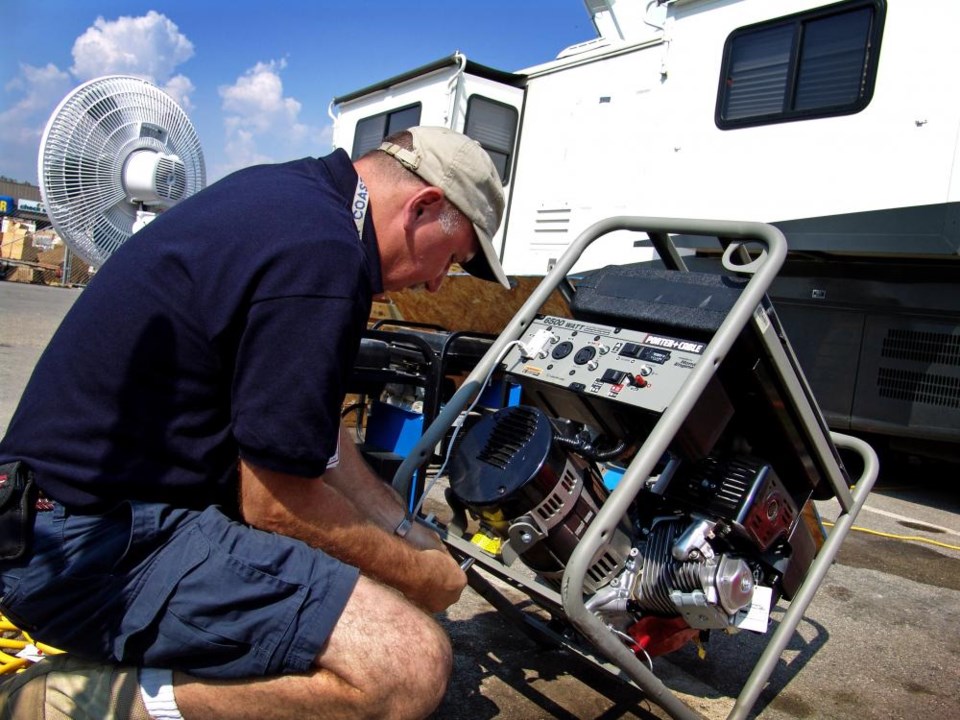When power lines are down and homes are without electricity, residents can restore energy to their homes or other structures by using a generator as an alternative power source. Purchasing a backup generator removes a lot of the inconvenience that comes with outages. However, generators must be used properly to ensure the complete safety of all parties involved, from the homeowner to children and pets to the linemen working on your power lines to restore full power to the neighborhood.
The primary hazards to avoid when using a generator are carbon monoxide (CO) poisoning from the toxic engine exhaust, electric shock or electrocution, and fire. Follow the directions supplied with the generator. Read the following tips and information on safely using a portable generator in the event of a power outage.
Using a Generator at Home
- To avoid electrocution, keep the generator dry and do not use in rain or wet conditions. Operate it on a dry surface under an open canopy-like structure, such as under a tarp held up on poles. Do not touch the generator with wet hands.
- Be sure to turn the generator off and let it cool down before refueling. Gasoline spilled on hot engine parts could ignite.
- Store fuel for the generator in an approved safety can. Use the type of fuel recommended in the instructions or on the label on the generator. Local laws may restrict the amount of fuel you may store, or the storage location. Ask your local fire department.
- Store the fuel outside of living areas in a locked shed or other protected area. To guard against accidental fire, do not store it near a fuel-burning appliance, such as a natural gas water heater in a garage.
- Store the fuel outside of living areas in a locked shed or other protected area. To guard against accidental fire, do not store it near a fuel-burning appliance, such as a natural gas water heater in a garage.
- Plug appliances directly into the generator, or use a heavy duty, outdoor-rated extension cord that is rated (in watts or amps) at least equal to the sum of the connected appliance loads.
- Check that the entire cord is free of cuts or tears and that the plug has all three prongs, especially a grounding pin.
- Never try to power the house wiring by plugging the generator into a wall outlet. Known as “backfeeding,” this practice puts utility workers, your neighbors, and your household at risk of electrocution.
-
When using gasoline- and diesel-powered portable generators to supply power to a building, switch the main breaker or fuse on the service panel to the "off" position prior to starting the generator. This will prevent power lines from being inadvertently energized by backfeed electrical energy from the generators, and help protect utility line workers or other repair workers or people in neighboring buildings from possible electrocution. If the generator is plugged into a household circuit without turning the main breaker to the “off” position or removing the main fuse, the electrical current could reverse, go back through the circuit to the outside power grid, and energize power lines or electrical systems in other buildings to, at, or near their original voltage without the knowledge of utility or other workers.
-
- Remember, even a properly connected portable generator can become overloaded, resulting in overheating or generator failure. Be sure to read the instructions.
- If necessary, stagger the operating times for various equipment to prevent overloads.
How to Prevent Carbon Monoxide (CO) Poisoning When Using a Generator
- Never use a generator, grill, camp stove or other gasoline, propane, natural gas or charcoal-burning devices inside a home, garage, basement, crawlspace or any partially enclosed area.
- Keep these devices outdoors, away from doors, windows and vents that could allow carbon monoxide to come indoors.
- Opening doors and windows or using fans will not prevent CO buildup in the home. Although CO can't be seen or smelled, it can rapidly lead to full incapacitation and death. Even if you cannot smell exhaust fumes, you may still be exposed to CO. If you start to feel sick, dizzy, or weak while using a generator, get to fresh air RIGHT AWAY - DO NOT DELAY.
- Install CO alarms in central locations on every level of your home and outside sleeping areas to provide early warning of accumulating carbon monoxide. Test the batteries frequently and replace when needed.
- If the carbon monoxide alarm sounds, move quickly to a fresh air location outdoors or by an open window or door. Call for help from the fresh air location and remain there until emergency personnel arrive to assist you.
Information provided by the American Red Cross and Sussex EMC.




